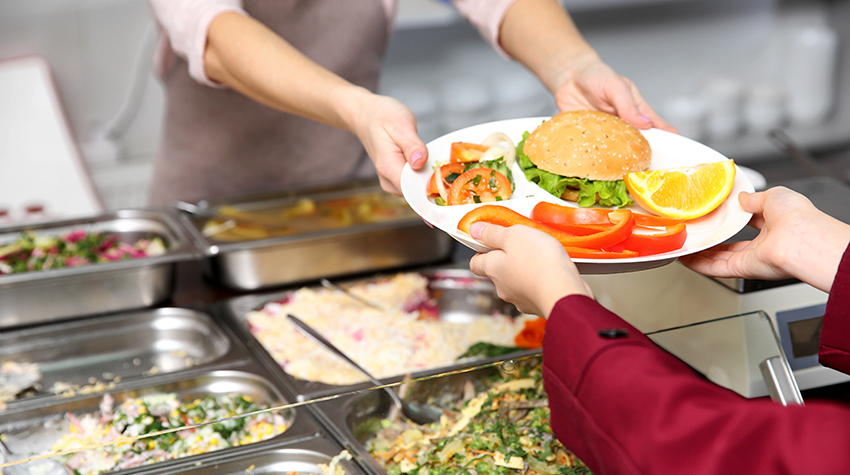School foodservice operators face numerous challenges every year, from funding to food regulations to food preparation and service. When it comes to preparation and service, operators have to consider student participation, timing and procurement,1 among other things. With about 30 million students participating in the National School Lunch Program everyday,1 foodservice operators have their work cut out for them, especially when you factor in a budget of only around $1 per meal.1
K–12 foodservice operators are tasked with serving wholesome, nutrient-dense meals everyday while working to satisfy specific expectations and requirements. Below are three of the top challenges facing operators and what they can expect in the year ahead.
Student Engagement
Getting students excited about lunch is often one of the biggest challenges to increasing participation. Fortunately, many foodservice operators have realized that students who are involved from the start are often more engaged in the program. Student-driven solutions such as taste testing, recipe development, and student cooking competitions where the winning recipe is featured on the menu1 are just a few examples of how operators are empowering their students to get more involved.
As today’s youngest generations have a more diverse palate, there is a greater demand for bold flavors and ethnic-inspired cuisine. Research shows Mexican and Latin foods are among the most popular, with tacos, burritos and gorditas listed as K–12 menu favorites.1 Parents also report that their kids enjoy Japanese and Chinese fare,1 which could inspire new lunch offerings like noodle and rice bowls. In addition to flavor, customization is important to students who have come to expect it outside of schools.1 Nearly 90% of school districts have responded with some form of customization, like salad bars, entrée bars and even self-service flavor stations.2 From noodle bowls to nacho stations, there are a variety of diverse and flavorful options to capture student interest.
Time Constraints
Time constraints are an issue for many operators who want to offer healthy, scratch-cooked meals but often don’t have enough time. Therefore, operators have come to rely on convenience and value-added products and often seek out foods that require minimal steps to prepare.1 Even students feel they don’t have a sufficient amount of time for lunch, especially when dealing with long lunch lines.1 As a solution, many schools have started offering grab-and- go items like ready-to- eat packaged salads, soups and sandwiches, as well as snack packs and smoothies.1
Clean Label Products
Similar to the rest of the foodservice industry, menu transparency and clean label products—foods with no artificial flavors, colors or preservatives—are growing within the K–12 segment. More than half of school districts are currently serving cleaner label menu items, with over 80% of these looking to increase their clean offerings even further.2 Of those districts that have not yet embraced the clean label trend, nearly 40% of them report they are planning to change that.2
While serving clean label menu options is most common in the largest school districts,2 parents everywhere want to know their kids are getting healthy, high-quality ingredients as part of a carefully planned lunch program.1 To satisfy parents and emphasize the availability of high-quality food, many schools are making the extra effort to communicate their commitment to serving clean and healthy meals, and some have even started farm-to- school programs to source local ingredients.1
Even if farm-to- school programs aren’t an option for you, there are still a number of ways to get healthy, high quality ingredients. For example, Perdue Foodservice can help operators satisfy the diverse demand of both students and their parents. Whether seeking whole-grain, low-sodium, gluten-free, fully cooked, No Antibiotics Ever or even organic proteins, Perdue Foodservice can help with products that meet the guidelines for the school lunch program. PERDUE® HARVESTLAND®, KINGS DELIGHT® and CLUX DELUX® brands serve up great-tasting chicken and turkey products to meet a range of demands. rom student engagement to menu transparency, there’s no denying K–12 foodservice is a balance between convenience, value, nutrition and appeal.1 Luckily, there are more options than ever to help cultivate a successful K–12 foodservice program.
1 International Foodservice Manufacturers Association, Back to School: Deep Dive into the Current K-12 Segment (Executive Summary), 2017, http://www.ifmaworld.com/media/375527/2017-oct- sis_whitepaper_k-12- segment.pdf
2 School Nutrition Association, The School Nutrition Trends Report (Summary), 2017, https://schoolnutrition.org/uploadedFiles/Resources_and_Research/Research/2017-Trends- Report-Summary.pdf

